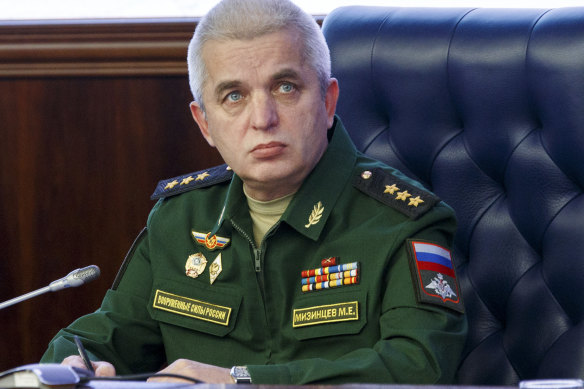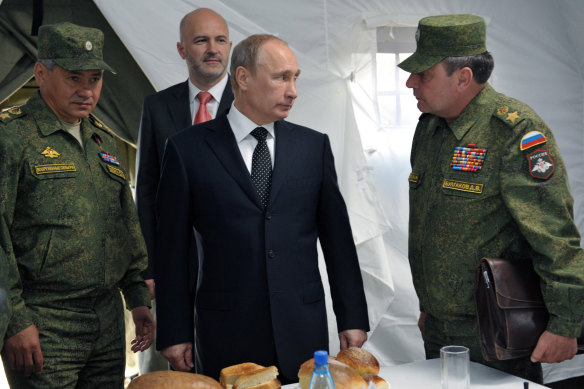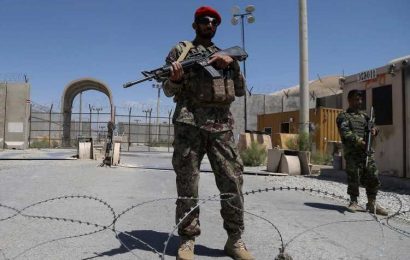Save articles for later
Add articles to your saved list and come back to them any time.
London: Russian President Vladimir Putin has sacked a top-ranking Defence Ministry official, Colonel General Mikhail Mizintsev, who was in charge of military logistics.
Mizintsev was dismissed after Russia’s offensive in eastern Ukraine floundered amid continuing issues with the supply of ammunition.
Colonel General Mikhail Mizintsev speaks to the media during Russia’s military intervention in Syria in 2018.Credit: AP
He was dubbed the “Butcher of Mariupol” by Ukrainian officials and sanctioned by the British government for his role in that city’s offensive last year.
Western analysts have questioned whether he was responsible for the destruction of the city, including strikes on a maternity hospital, because he was the head of the National Defence Management Centre in Moscow at the time.
The ministry has not commented but influential Russian military bloggers have criticised the sacking.
“He is one of my friends. I respect him a lot,” Alexander Sladkov, a pro-war Russian blogger, told his almost 1 million Telegram followers. “How, what, what for? It is difficult to guess??”
Mizintsev, 60, was promoted to deputy defence minister in September and put in charge of logistics.
Vladimir Putin, centre, with Dmitry Bulgakov, right, who was dumped in January.Credit: AP
He replaced General Dmitry Bulgakov who was sacked because of supply-line failures during the initial invasion of Ukraine.
Russian soldiers fighting around Bakhmut in Ukraine’s Donbas region have complained that supplies of artillery shells have run low, and men mobilised into the Russian army have said that their kit is substandard. No official reason has been given for Mizintsev’s sacking.
Putin has been accused of acting as an armchair military enthusiast throughout the war, switching military commanders and tinkering with orders despite never being a soldier.
A museum worker sits next to the portraits of members of the ‘Azov’ unit killed in Mariupol during a Russian attack last year. The photos are part of a new exhibition about the defence of the Azovstal steelworks.Credit: Getty
In January, he sacked the general in charge of his military in Ukraine and installed Valery Gerasimov, the chief of the general staff, as his campaign commander.
With his white hair and icy pale-blue eyes, Mizintsev is one of the few Russian army generals with any profile in the West.
He allegedly oversaw Russia’s brutal bombing of Aleppo during the Syrian civil war.
The National Defence Management Centre, which Mizintsev ran until September 2022, co-ordinates the Russian military’s response to events and hosts a super-computer designed to predict the outcome of conflicts and the development of rival armies.
AP photographer Evgeniy Maloletka with his World Press Photo of the Year image of Iryna Kalinina, a pregnant woman rescued from the Mariupol maternity hospital after a Russian strike. Kalinina survived, but her baby didn’t.Credit: AP
Meanwhile, Ukraine’s defence minister has warned expectations of a counter-offensive by his country in the northern spring are “over-heated”.
Oleksii Reznikov said Ukraine’s success in defending itself against Russia, and recapturing territory, had led to an assumption of victory.
“It is definitely over-heated, everyone wants another victory,” he told the RBC-Ukraine website. “We didn’t believe in victory before. We used to want Ukraine to survive at least minimally. But when the Ukrainian armed forces showed success, everyone began to believe in victory.”
Reznikov insisted Kyiv would require further Western support to expel Moscow’s forces.
“This is not a sprint,” the minister said. “When I realised that this is not a sprint, but a marathon, then I said to myself, ‘Wait, in order to run the last 195 metres of the marathon distance, you need to hold on for 42 kilometres before that’.”
Ukrainian officials have long said they were planning new operations to liberate land captured by Russia since the invasion in February last year.
Operational details are said to be known only to a small group around President Volodymyr Zelensky. The counter-offensive is likely to focus on southern Ukraine in the direction of the occupied Crimean Peninsula.
Western analysts have suggested Kyiv could also launch attacks on contested towns in the eastern Donbas region, such as Bakhmut, Vuhledar and Avdiivka, which Moscow has expended vast resources attempting to capture.
A recently leaked US intelligence assessment suggested Kyiv could fall “well short” of its forthcoming goals because its forces would struggle to sustain the offensive. But on Wednesday, the senior American commander in Europe signalled that Washington was now less concerned about Ukraine running out of supplies.
“Over 98 per cent of the combat vehicles are already there,” said General Christopher Cavoli, who is also the supreme allied commander of NATO. “I am very confident we have delivered the material that they need, and we’ll continue a pipeline to sustain their operations. The Ukrainians are in a good position.”
NATO allies have equipped at least nine of Ukraine’s 12 new brigades in the lead-up to the long-heralded offensive, delivering more than 230 tanks and 1550 armoured vehicles, according to Secretary-General Jens Stoltenberg. “This will put Ukraine in a strong position to continue to retake occupied territory,” he told a news conference on Thursday.
Ukraine is not expected to launch a single large-scale offensive but smaller pinpointed efforts designed to break Russia’s defensive positions at several points along the front line, Western officials added.
The Telegraph, London
Get a note directly from our foreign correspondents on what’s making headlines around the world. Sign up for the weekly What in the World newsletter here.
Most Viewed in World
From our partners
Source: Read Full Article











